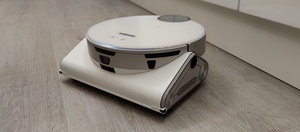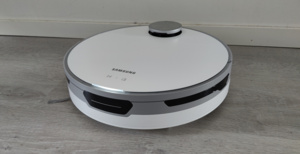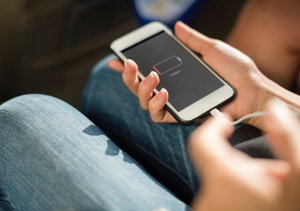
Review: Samsung Jet Bot 90 AI+ - a high-end robot vacuum cleaner
 Samsung sent us their modern, top-level robot vacuum cleaner for our test and review.
Samsung sent us their modern, top-level robot vacuum cleaner for our test and review.
The Samsung Jet Bot 90 AI+ has a whopping price tag of around €1,400, and is the Korean CE giant's first attempt to push itself to the top of the world of robot vacuum cleaners.
We tested the robovac, which first went on sale in 2021, for a month and a half. As always, in our test we examine not only the cleaning power of the vacuum cleaner, but also its ease of use and especially the practicality of the device in a Finnish home.
The first half of the test period was spent in a typical and "easy" Finnish home, from the point of view of a robovac. The other half was a more challenging environment, including the presence of a pet that sheds hair, a bunch of carpets of varying thickness and shape, and a significant number of different obstacles that can make life difficult for a robot vacuum cleaner.
Due to our extensive past experience testing robot vacuum cleaners, we have a good understand of the potential challenges and problem areas that a robovac can encounter while doing its duty.
- Samsung Jet Bot 90 Ai+ appearance and design
- Technical information
- Self-emptying charging dock
- Samsung deployment
- Samsung SmartThings smartphone app
- Specialty: Camera surveillance
- Activities
- How should a robot vacuum cleaner be used?
- Battery life
- Carpets
- Furniture
- Other obstacles - and their avoidance
- Pets
- Problems
- Cleaning traces
- Summary
- Is the Samsung Jet Bot 90 AI+ worth buying?
- Pros
- Cons
- The stars

 We were given one of Samsung's new generation of robotic vacuum cleaners for a review: the new Samsung Jet Bot 80+, which is also sold under the name Samsung Jet Bot+.
We were given one of Samsung's new generation of robotic vacuum cleaners for a review: the new Samsung Jet Bot 80+, which is also sold under the name Samsung Jet Bot+.
 When browsing mobile phones, headphones, Bluetooth speakers, etc. a device's IP classification is often mentioned. This refers to the devices waterproof and dust-resistance rating. There are a large number of IP classifications however, and most people don't know much about them. Here, we take a look at what the numbers mean.
When browsing mobile phones, headphones, Bluetooth speakers, etc. a device's IP classification is often mentioned. This refers to the devices waterproof and dust-resistance rating. There are a large number of IP classifications however, and most people don't know much about them. Here, we take a look at what the numbers mean.
 Many home network problems are related to a slow Wi-Fi connection, which causes tension for all family members using a wireless network. At worst, the problems cause video stuttering, slow download speeds, and can even make remote work difficult or impossible.
Many home network problems are related to a slow Wi-Fi connection, which causes tension for all family members using a wireless network. At worst, the problems cause video stuttering, slow download speeds, and can even make remote work difficult or impossible.
 Do you feel like your phone battery is draining too quickly? The phone is relatively new, but the battery doesn't last as long as you think it should? There can be many reasons for this - and some of them have clear and easy solutions.
Do you feel like your phone battery is draining too quickly? The phone is relatively new, but the battery doesn't last as long as you think it should? There can be many reasons for this - and some of them have clear and easy solutions.
 Sometimes, Android updates can go horribly wrong. The intentions of manufacturers are usually good. After all, new updates bring about new features, performance improvements, security improvements, etc. Every now and then, however, a new Android update can pose significant problems for end users.
Sometimes, Android updates can go horribly wrong. The intentions of manufacturers are usually good. After all, new updates bring about new features, performance improvements, security improvements, etc. Every now and then, however, a new Android update can pose significant problems for end users.







